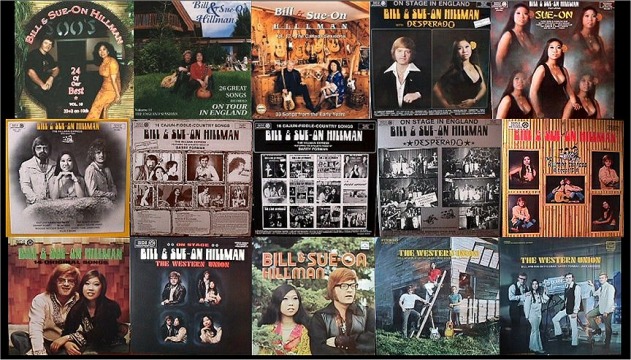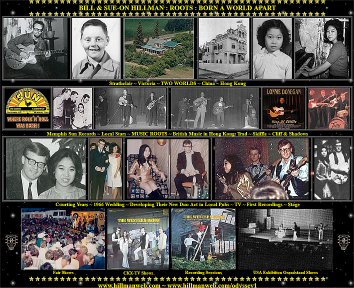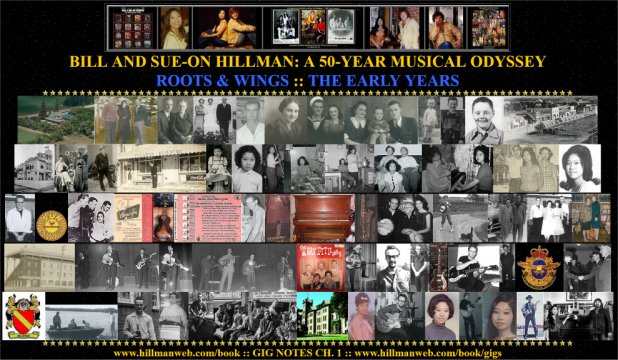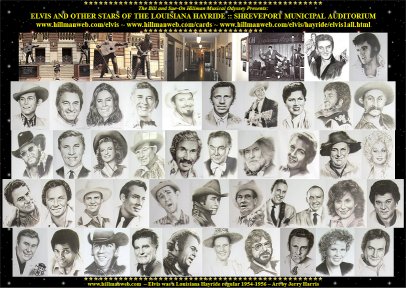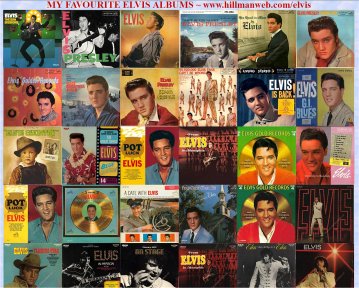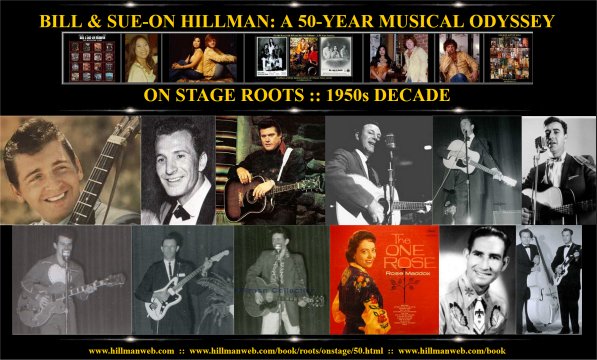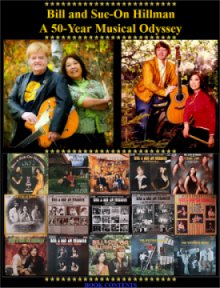Family
Roots and Jams
War Baby Follows The Muse: Strathclair
to Newfie
The music has always been there.
I was born in wartime, January 11, 1943. Conception took place in Halifax
where my dad, Jerry Hillman, was stationed with the Royal Canadian Navy
but later, when my debut onto the world stage was imminent my mom, Louise,
returned to Strathclair MB so I could be born at her birthplace surrounded
by family. When I was old enough to travel we returned to the East coast
to be with my dad. By this time he was stationed in St. John's, Newfoundland.
The ferry to the island recently had been torpedoed by a German U-boat
so dad arranged for us to take a passenger plane for the last leg of the
trip -- he also had to arrange for passports as Newfie, at that time, was
still a British possession. From that time on I was exposed to music as
my parents' social life mostly involved jam sessions with friends. Dad
blew the trumpet and sax while mom played accordian, and piano when available.
My mom and I followed Dad to his RCN postings in Newfoundland, Halifax,
and Victoria . . . and music was always there.
www.hillmanweb.com/cards/early/rcnall.jpg
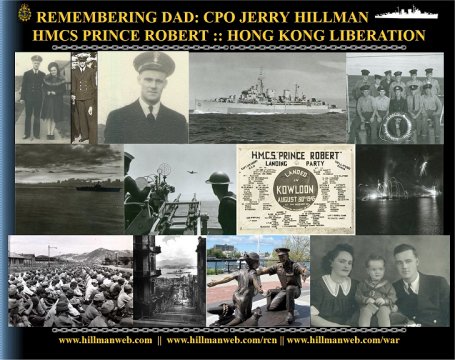
WWII
Music: Big Bands and Hong Kong Girl Singers
The music from those war years must
have left its mark as I'm always filled by waves of nostalgia whenever
I hear the big band sounds and hits from that era. In '44 dad was transferred
to Victoria, BC (Esquimalt and Comox) and since my parents both loved to
go to the movies, some of my first memories are of theatres with their
magic images and soundtracks.
Near the end of the war dad volunteered to serve on
HMCS Prince Robert, a ship that was fitted with the latest in radar and
armament and was part of a joint British/American fleet to free the Canadian
POWs and to help facilitate the Japanese surrender in the Pacific. Mom
and I returned to Strathclair to await his return. I have vague memories
of his departure and return -- especially the goodbye hugs as he held me
on his knee. His ship had spent the summer of '45 in Hong Kong harbour
and he returned with fantastic souvenirs, photos and stories that fired
my imagination and which seemed to inculcate a livelong appreciation and
fascination for travel, the military, adventure, Chinese culture, and exotic
lands and music.
Dad had fond memories of Hawaiian and Hong Kong entertainment
troupes who had presented music and dance shows on board ship and during
shore leave. One curious thing I remember him saying was that the Chinese
girls -- the girls in the entertainment troupe were probably singing Chinese
opera, somewhat strange sounding to Western ears -- were terrible singers...
ah, if only he could have seen into the future : )
Magic
Portal: Googling the Dial
www.hillmanweb.com/cards/roots/schoolall.jpg
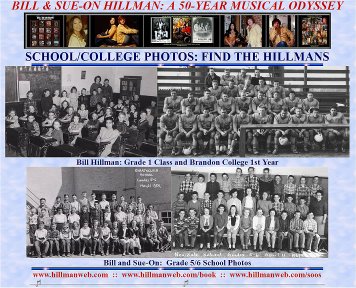 After WWII I grew up on our family farm, Maple Grove,
a half-section grain, dairy and livestock farm homesteaded by my great
grandfather in 1878. This marvellous place with its pastures, waving grain
fields, woodlots, towering spruce trees, ravine, sloughs, old stone buildings,
and majestic red brick house would be the centre of my world until I left
for university in 1961.
After WWII I grew up on our family farm, Maple Grove,
a half-section grain, dairy and livestock farm homesteaded by my great
grandfather in 1878. This marvellous place with its pastures, waving grain
fields, woodlots, towering spruce trees, ravine, sloughs, old stone buildings,
and majestic red brick house would be the centre of my world until I left
for university in 1961.
Radio became my window to the world and I constantly
roamed the dial of our big Westinghouse floor model, bringing in songs
and voices from far-off places -- the equivalent of today's Internet. I
became a sponge for every kind of music and radio programme -- shows that
featured super heroes, mystery, comedy, SF, variety entertainment . . .
and music of all styles.
Through the magic of radio I discovered the stars of
Sun records and followed the birth of rock and roll. In fact, I heard Elvis,
the Hillbilly Cat very early -- on stations beaming music from the deep
south in 1954: WSM, WLS, KXEL, KWKH, etc. And, wired into this booming
radio, was a 78 rpm turntable on which I played, over and over, the family
collection of records: Bing Crosby, Hank Williams, big bands, pop songs
and western swing.
A few years later I was able to purchase a reel-to-reel
tape recorder which allowed me to tape home recordings as well as radio
and TV shows. I was then able to build up a permanent library of thousands
of old time radio shows. I traded with fellow collectors in the US for
the shows that had fired my imagination as a kid in the '40s and '50s.
One of the first shows I traded for was Orson Welles' 1938 broadcast of
The War of the Worlds.
www.hillmanweb.com/cards/roots/warworldsall.jpg
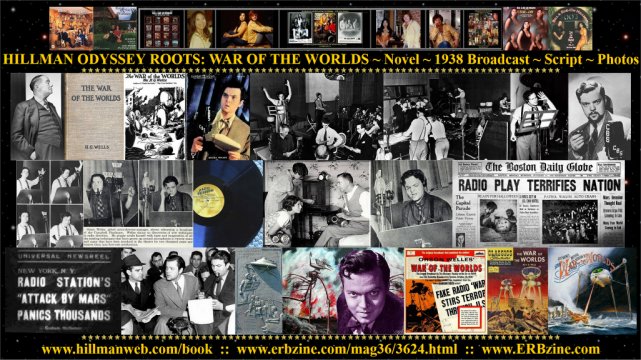
Nostalgia
Fanatic
Not long after I got my first reel-to-reel
recorder I bought 77 episodes of the 1932 Tarzan series starring Joan Burroughs
(Edgar Rice Burroughs' daughter) and her husband Jim Pierce (Jim starred
as one of the last silent Tarzans in Tarzan and the Golden Lion). That
got me started on years of trading for OTR shows reel for reel via mail
-- thousands of shows. I catalogued them on my old typewriter and Gestetner
copier. Later I traded copies with Vern Coriell his House of Greystoke
publications and also sent them down to the Pierces after meeting them
in Tarzana. In return they sent back all the Burroughs, Inc. titles and
DJs they had in the warehouse.
Later in the early '70s, during our music tour in the
Peace River country, a morning DJ who MCed our show invited me to take
away 600 16" ET discs stored in the radio station crawl space. I dropped
around at 5 am and filled our VW Westphalia camper with them. The rest
of the Western Canada tour was very cramped – Sue-On is a very patient
and understanding mate :) It's been a bit of a struggle to keep my
Gates 16" turntables and reel-to-reel recorders in working condition through
the years – I have two stacks of worn out Reel recorders and VHS recorders.
Since then I've collected thousands more shows in MP3 format on disks and
computer hard drives.
I discovered MAD magazine with issue 28 and immediately
sent for their four back issue mags and bought all the pocket book reprints
through the years. Their subscription offer for the magazine back then
included a free issue of MAD comic #1 from 1952 which started me on a quest
to find all the MAD comics that predated their magazine format. I collected
the magazine through the years but gave up that obsession when they went
colour with ads and raised the price. The Tarzan parodies that Mad, Cracked,
National Lampoon, etc. featured are reprinted in my ERBzine.com
site the official Edgar Rice Burroughs Tribute site of 15,000 Webpages.
50
Top Hits On 78 RPM!
We had cattle and about 1,000 laying
hens which I had to feed by carrying water, grain and chop by pails. My
audience of cows and chickens gradually learned to put up with my vocal
renditions of the hits of the day. I hauled out the manure, gathered eggs,
milked the cows, and did the crushing, as well as shovelling snow, grain
and coal. What money I saved from doing these daily chores went into buying
records, books, magazines and comics.
I talked my mom into sending for records through an
ad that offered 50 hit songs for just a few dollars. Too good a deal to
pass by. The package that arrived in the mail wasn't quite what we had
expected, however. Each 78 rpm disc had three somewhat abbreviated songs
per side ... and they weren't by the original artists. But there was some
good stuff there: Sh-Boom, Sincerely, Moments to Remember, The Man in
the Raincoat, etc. - pop and C&W and a whole lotta stuff I'd never
heard of.
Life
Revolving at 78 RPM
My first real record purchase was
at G.V. Henderson's Drugstore:
That's All Right Mama b/w
Blue
Moon of Kentucky by Elvis Presley and the Blue Moon Boys on RCA Victor
78 rpm. Before long I had bought out his whole stock of Elvis records and
had the entire collection of the singles Elvis had originally released
on Sun Records.
The next treasure trove of singles came as prizes for
selling school magazine subscriptions: Fats Domino, Jack Scott, Gene Vincent
and Little Richard. Sadly there was very little music in our school. We
did however, get permission to clear out an old junk room in the school's
basement and on days when the weather was too miserable for us to play
baseball or football outside (guys and gals played tackle football all
winter out among the snowbanks), we listened and danced to records.
These were truly exciting music times -- the birth
of rock 'n' roll and my own music awareness -- and today there are very
few hits from the '50s and '60s that don't generate some memory from the
past. My life then, as now, seemed to revolve around music.
Rock
Roots
www.hillmanweb.com/cards/early/elvis78h20.jpg
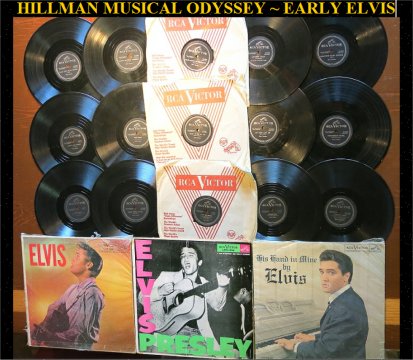 The arrival of Elvis on the pop scene was the event that
kicked our Musical Odyssey into full gear. It led to gathering massive
record, tape, video and book collections, an obsession for all things guitar,
and a deep love for music of all kinds -- especially blues, C/W, and rock
'n' roll. The emergence of The Beatles a few years later only kindled the
fire. Later, Sue-On and I incorporated many songs from both acts into our
performing repertoire.
The arrival of Elvis on the pop scene was the event that
kicked our Musical Odyssey into full gear. It led to gathering massive
record, tape, video and book collections, an obsession for all things guitar,
and a deep love for music of all kinds -- especially blues, C/W, and rock
'n' roll. The emergence of The Beatles a few years later only kindled the
fire. Later, Sue-On and I incorporated many songs from both acts into our
performing repertoire.
Road tours gave us the chance to trace the roots of
both these acts. We stood on stages that Elvis had performed on for the
Lousiana Hayride and Grand Ole Opry, visited his old Memphis haunts, marvelled
at the Sun Records Studio in Memphis and the RCA studios on Music Row in
Nashville, explored Graceland and his two jet aircraft, thrilled at his
live performance in Las Vegas, and were shocked when we learned of his
death while we were on tour in England.
Our tracking of Beatles roots took us even farther
afield in Liverpool, London, clubs in NE England and the Reeperbahn in
Hamburg, Germany.
10
Inch Magic Platters
I wore out the family's stacks of
78 RPMs on a turntable we had wired to our big console radio. When Elvis
records became available on RCA in 1956 every penny I could scrape up went
to buying these $1 discs. But the big old 78s in my collection just didn't
have the pizzazz of the new unbreakable 45s and LPs with their stacking
turntables, colourful photos and peer acceptance.
So, for many months leading up to Christmas '56, I
started a campaign to make my parents very aware that our old turntable
was terribly obsolete. Success! Under the tree that year was a portable
RCA record player that could play all three speeds and all sizes of records.
Along with this technological marvel was a selection of records from various
members of the family: Elvis' second album, Bill Haley, Pat Boone and Crazy
Otto (my Aunt Merna was a real fan), Tennessee Ernie Ford (my Nannie was
a fan), and a few more.
My record collecting and guitar playing now went into
full gear as I could hide away in my room and play along for hours every
day, picking guitar riffs off my growing collection: Elvis, Johnny Cash,
Carl Perkins, Lonnie Donegan, Dale Hawkins, Gene Vincent, et al. This collection
grew in leaps and bounds when I joined the RCA record club: Chet Atkins,
Hank Snow, bluegrass, etc.
That
Ain't How Jerry Lee Plays It
My mother, sensing a bit of a music
obsession, enrolled me in piano lessons for a couple of years. Silly kiddie
tunes, scales and boring practises just never captured my imagination...
this wasn't the music I was hearing in my head. My
sister Bonnie took the lessons much more seriously and became very accomplished
on the keys. . . but alas . . . not for me.
Mom tried to kindle the fire by buying sheet music
for songs in which I had shown some interest: Love Me Tender, Don't
Be Cruel, Third Man Theme, etc. Dad's sister, Aunt Merna, tried to
get me to put some excitement into my dreary plodding by giving me pointers
on syncopation and rhythm. My music teacher added an element of fear through
weekly scoldings and rapping my fingers with her pencil. And around this
time Jerry Lee Lewis came on the scene with his pumping piano to show just
how exciting a piano could sound. But he was too late.
Little
Sister
www.hillmanweb.com/cards/early/family1all.jpg
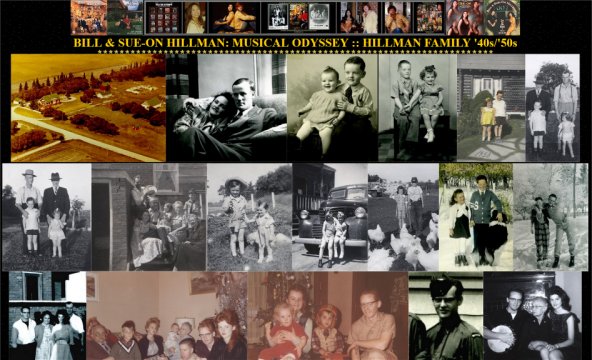 Living on a farm in the country meant that I didn't have
a chance to mix much with kids my own age. But this had advantages as well.
My grandparents lived with us and we all shared a love for music, movies,
radio, and books which created close family bonding. The birth of my sister
Bonnie was an exciting event. She was four years younger, but soon
I had a little companion to play with and to join me in adventures in make-believe
worlds.
Living on a farm in the country meant that I didn't have
a chance to mix much with kids my own age. But this had advantages as well.
My grandparents lived with us and we all shared a love for music, movies,
radio, and books which created close family bonding. The birth of my sister
Bonnie was an exciting event. She was four years younger, but soon
I had a little companion to play with and to join me in adventures in make-believe
worlds.
Again, music became a bonding force and she became
much more accomplished than I on piano. Bonnie developed a fine singing
voice which led to some neat sing song sessions. She grew into a beautiful
lady and worked as a model when she moved to Winnipeg. She also worked
as a travel agent and led vacation tours to exotic places.
That love of travel never left her and after she married
Dr. Michael Schneider, she and their four kids moved to Saudi Arabia where
Michael was revered as an esteemed surgeon. From this location they
had many adventures as they travelled worldwide and the kids were enrolled
in some of the world's finest Medical schools. Daughter Lee Noelle showed
that love of adventure by spending a high school year by travelling around
the world as a working/learning crewman/student on a tall ship.
Hello
Monterey
Piano lessons weren't cool. . .
this was a little before Jerry Lee. Elvis & Scotty and Johnny &
Luther, and all the cool rockers played guitar. So. . . dad came home from
Winnipeg one night with a Harmony Monterey archtop he had bought at Ray
Hamerton's. That was cool. . . a dream come true.
But it was tough going for awhile since the strings
hovered way above the fingerboard -- bleeding digits until calluses were
built up. Dad showed me a few runs . . . and one day proudly boasted that
he had heard a hit song on the radio -- I Walk The Line -- that
used the same runs he had taught me. For a while then, Luther Perkins was
a bit of a mentor : ).
Encouraged by all this, dad soon added a 5-string banjo
and autoharp to my arsenal. Uncle Don then showed me how to put some chords
to some simple folk songs and I was on my way -- picking up ideas, riffs,
chords from every guitar player I saw. Music continued to be a driving
force: I sent for a Doc Williams acoustic guitar course from a Wheeling
West Virginia radio station, and Mom bought music folios with guitar chords.
Rewards
of Myopia
About the only good thing about
being shortsighted and having to wear glasses was that I got to go to Winnipeg
for appointments with an eye doctor in the Boyd Building. I saw Elvis's
Love
Me Tender, soon after it was released, in the Metropolitan Theatre
-- well, "heard" more than "saw" because I had just come from an eye test
and examination and had drops in my eyes.
I also went to my first major music concert -- at the
Playhouse Theatre -- little knowing that in 20 years I would have the thrill
of appearing on this same stage many times myself. But back then though,
I was dazzled by the lights, the sound, the applause, the velvet curtains
on the stage -- and the guitars! The show featured Jim Reeves, Johnny Horton,
Country Johnny Mathis and Charlie "Hot Rod Lincoln" Ryan.
On later trips I returned home with hard-to-find Lonnie
Donegan skiffle albums and LPs by England's guitar instrumental group,
The Shadows.
Up
Around The Bend
http://www.hillmanweb.com/strathclair/bend
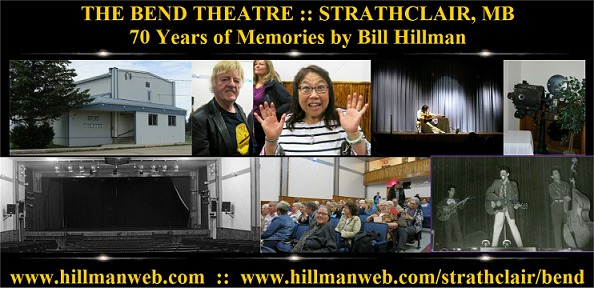 The
Strathclair Bend Theatre has been one of the major influences on my
love of music, movies, and entertainment. I have fond memories of the times
my grandfather, Jack Campbell, took his 4-year old grandson to the construction
site of what would become the Bend Theatre. The theatre was a dream project
of Grandpa's friend, Paddy Trim. Mr. Trim made a deal with Alex Kippen,
who owned a lumber mill in the Riding Mountain area, to provide the lumber
for construction. I remember standing in awe in the middle of this huge
building which had just started construction. Up until this time
I remember attending the showing of movies in the Strathclair Hall -- sort
of a make-shift theatre. It was a thrill then, when our family attended
the grand opening of the luxurious finished theatre. The debut movie was
"The Egg and I" which saw the debut of the Ma and Pa Kettle characters
which were soon spun off into a series of their own. The theatre derived
its name in recognition of the original
Strathclair settlement which was located some distance north on a "bend"
in the Little Saskatchewan River. The town was moved south for better rail
access when the CPR line was constructed through that area.
The
Strathclair Bend Theatre has been one of the major influences on my
love of music, movies, and entertainment. I have fond memories of the times
my grandfather, Jack Campbell, took his 4-year old grandson to the construction
site of what would become the Bend Theatre. The theatre was a dream project
of Grandpa's friend, Paddy Trim. Mr. Trim made a deal with Alex Kippen,
who owned a lumber mill in the Riding Mountain area, to provide the lumber
for construction. I remember standing in awe in the middle of this huge
building which had just started construction. Up until this time
I remember attending the showing of movies in the Strathclair Hall -- sort
of a make-shift theatre. It was a thrill then, when our family attended
the grand opening of the luxurious finished theatre. The debut movie was
"The Egg and I" which saw the debut of the Ma and Pa Kettle characters
which were soon spun off into a series of their own. The theatre derived
its name in recognition of the original
Strathclair settlement which was located some distance north on a "bend"
in the Little Saskatchewan River. The town was moved south for better rail
access when the CPR line was constructed through that area.
The Bend was a magical place. Long before the advent
of television in our community this was my window to the world. From that
opening in 1947 all through my toddler and teenage years it provided wonderful
entertainment to my family -- indeed, my weekly allowance was nearly always
spent at the Bend box office which was my portal to a full night's entertainment
on the giant silver screen: newsreels, Three Stooges amd other comedy shorts,
Warner Brothers and Disney cartoons, adventure and SF serials, and exciting
previews of the upcoming features. Then the house lights would go on and
girls with concession trays full of ice cream bars, candy, popcorn, etc.
would make their way down each aisle. While the girls were selling these
treats, slides would appear on the screen providing local news and ads.
When the lights dimmed we settled in to watch the main feature -- all the
latest films that Hollywood had to offer. My favourites in those early
years were westerns, Tarzan movies,
science
fiction, musicals and screwball comedies.
The next major construction to the theatre was the
expanding of the stage area in 1954 to accomodate the new wide-screen Cinemascope
films. I remember attending what I believe was the first such film shown
there: Prince Valiantstarring
Robert Wagner. It was disappointing to see much of the beauty of the proscenium
arch removed for the expansion.
These influences stayed with me and evolved over the
years -- leading me into becoming a compulsive collector of many thousand
movies and radio shows on tape, disc and computer. The wonder of far-off
exotic places shown on that screen led me to become a compulsive
traveller to distant lands -- something that my wife Sue-On and I have
done constantly since we were married in 1966 -- it was also major impetus
to become a geography teacher and professor.
The Bend also provided a showcase for live entertainment
-- both local and professional. Winnipeg radio stations promoted entertainment
troupes by featuring live music shows on the air. These bands would use
this exposure to advertise their live shows in showhalls and theatres such
as The Bend. Station DJs, such as Porky Sharpeno, would moonlight as emcees
on these shows and would usually plug the show all week on their radio
shifts. The stage shows featured a nice mix of country songs and instrumentals,
pretty girl singer, cornball humour, audience participation, costumes,
lighting (black light was a favourite gimmick), and sale of photos, programmes
and songbooks.
The first such show I remember was that of the Ray
Little Gang. I still have the photo and song booklet that they sold at
this gig. In fact, years later when Sue-On and I were looking for good
material to record on our albums I referred to this booklet for the words
to The
Kentuckian Song and I taught her the melody by memory. (This was
many decades before the Internet and Google made such song searches much
easier).
I have fond memories of being on the Bend stage in
the early days -- mostly Christmas concerts: doing a poetry recitation
as a scared-stiff grade one student and later performing in a silly skit
in shorts and a sailor hat for an air cadet show, and still much later
playing a guitar solo of "Silent Night." During my 30 years as a high school
teacher at Strathclair Collegiate we often made use of the Bend for school
dramas, initiations and graduation events. I remember, in all my years
as a devoted a movie-goer, that I usually sat half-way down off the right
aisle. Curiously, I chose this same location for every movie I attended
in Brandon's Strand theatre after moving to the Wheat City as a Brandon
College student . . . and even later when we moved to Brandon to take over
SOO'S Restaurant. Old traditions die hard. Sadly, Sue-On
and I never had a chance to perform our music on the Bend stage.
Elvis
And Chet Come To Town
www.hillmanweb.com/cards/roots/bendall.jpg
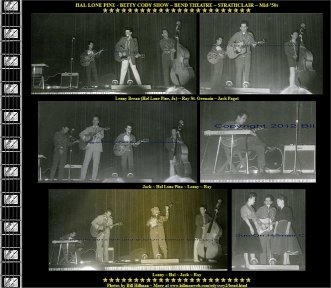 I was a devoted fan of the early rock 'n' roll that came
out of Sun Studios of Memphis: Elvis
Presley, Johnny Cash,
Carl Perkins, Jerry Lee Lewis et al. The stage show in our local Bend Theatre
that stands out most in my memory was the Hal Lonepine / Betty Cody Show
in the mid-'50s. Accompanying this husband and wife singing team was their
15-year-old son, Hal Lonepine, Jr. on Gretsch guitar. The kid was incredible
. . . and he later became even more incredible when he set the guitar
and jazz world on its ear. In those later years he dropped the Jr. stagename
and performed under his real name: Lenny Breau.
I was a devoted fan of the early rock 'n' roll that came
out of Sun Studios of Memphis: Elvis
Presley, Johnny Cash,
Carl Perkins, Jerry Lee Lewis et al. The stage show in our local Bend Theatre
that stands out most in my memory was the Hal Lonepine / Betty Cody Show
in the mid-'50s. Accompanying this husband and wife singing team was their
15-year-old son, Hal Lonepine, Jr. on Gretsch guitar. The kid was incredible
. . . and he later became even more incredible when he set the guitar
and jazz world on its ear. In those later years he dropped the Jr. stagename
and performed under his real name: Lenny Breau.
The show also featured the Ward Sisters and steel/fiddle/bass
player, Jack Paget, who came out later in a Grampa Jones type costume and
persona to add a bit of comedy relief. The guest singer was a very young
and dynamic Elvis impersonator named Ray St. Germain. Ray also went on
to become a major performer with hit records, international tours and his
own television shows.
One of our greatest thrills was meeting Ray, one of
our early influences, many years later at the Manitoba Association of Country
Artists Award Show. We and Ray were both up for the Manitoba
Entertainers of the Year Award. . . and Sue-On and I were more surprised
than anyone in the room when we were announced the winners of this major
award.
A few years after the Bend appearance I saw Lenny a
few times in Winnipeg. One time was in a coffee house ( I believe it was
called The Establishment) where he soloed all night . . . on a Hofner bass!
Another time was in the Town and Country lounge in the mid-'60s when he
sat in with the Guess Who. Guess Who leader Chad Allen and I were both
attending a summer school class at the University of Manitoba -- Atomic
Physics of all things. I often joined Chad in evenings at the lounge where
he, Randy Bachman, and Jimmy Kale were playing -- without a drummer. Gary
Pederson was underage but for some reason was allowed to play with the
house band up in the main showroom. As usual, Lenny's performances were
quite unbelievable.
Royal
American Shows
Another big event during my teen
years was the annual Provincial Exhibition in Brandon. A trip to Brandon
would give me a chance to roam through the record and book shops. Brandon
Fair always offered great entertainment on the Grandstand and the two big
tent sideshows -- one with black performers, one with white -- had exciting
bands and dancers, albeit a wee bit racy for a youngster.
A few years later I would be performing on TV remotes
and various stages at the fair, but in these early years the closest I
came to performing was giving 4-H Club demonstrations and showing Rhode
Island Red chickens since I was a member of the Strathclair Poultry Club
-- not exactly a glamorous introduction to the world of show business.
China
Doll
Meanwhile, on the other side of
the world, in Hong Kong, Sue-On
was coping with being separated from her mother who was stranded in China,
and from a father in Newdale, MB, whom she had never seen. Her grandparents
had enrolled her in a rather harsh and very foreign Catholic school and
she was absorbing the metropolitan sights and sounds of this bustling English
colony.
Luther
Played the Boogie Woogie
www.hillmanweb.com/cards/roots/sunall.jpg
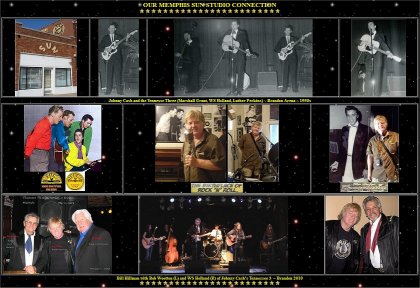 Many Brandon music shows stand out in my memory - especially
three shows featuring Johnny Cash. Seeing the first Johnny Cash / Jim Reeves
Show in the old Brandon arena was a real thrill. I got some great photos.
Many Brandon music shows stand out in my memory - especially
three shows featuring Johnny Cash. Seeing the first Johnny Cash / Jim Reeves
Show in the old Brandon arena was a real thrill. I got some great photos.
After the show when the stars headed across the arena
floor to the dressing room area, the majority of autograph seekers followed
after them. But Luther Perkins, Marshall Grant, and W.S. "Fluke"
Holland of Johnny's Tennessee Three stayed in the stage area to pack up.
This was in the days before roadies and big tour buses.
I saw Luther alone at the side of the stage and made
my way over to him to boldy ask if I could try out his Fender guitar. He
said "Yup" and this led to my first real guitar lesson. Luther wasn't a
really great accomplished guitarist... he probably didn't know many more
chords than I at that time... but the lessons I learned in that short time
about interaction with fans and the importance of creating your own style
were invaluable.
Luther's "boom-chick" style of damped guitar and simple
memorable riffs is probably one of the most imitated. Sadly, he died in
a house fire a few years later. Soon after Luther's death, guitarist, Bob
Wootton, was enlisted to join the Tennessee Three. Wootton led the Tennesse
Three (he does J.R.'s vocals and Luther's guitar) for many years after
Johnny's death until failing health forced him to retire in 2014. We caught
their show twice and video taped the second show we attended. I'm very
proud of one of the after-show photos that my friend Bill Stadnyk snapped
while I was chatting with Bob and "Fluke" Holland.
Simon
Crumb
The other major Brandon musical
event for me was also at another old arena concert. One of the stars was
Ferlin Husky, a dynamic entertainer whose contribution to country music
seems to be somewhat overlooked.
What impressed me most about the show, though, was
his lead player. I could hear steel guitar sounds, but there was no steel
on stage. Upon moving closer to the stage I soon deduced that the lead
player was getting these long sustained sounds with the aid of a volume
foot pedal. It wasn't long before I had bought a DeArmond pedal and was
imitating his style -- a device I have used ever since, and is vital to
my guitar sound and style.
Window
to the World. . . and Brandon
Back in the early days of television
in Southwestern Manitoba, one of the highlights of "going to town" in Strathclair
was to join the crowd huddled around the window of the Somers Electric
shop. Set up for public display was a Westinghouse 19 inch television set
which pulled in a weak signal from CKX-TV Brandon -- 60 miles to the southeast.
Across this magic, flickering, black and white window
to the world paraded a multitude of faces, places and sounds: movie stars,
radio stars, variety performers, cartoons, TV actors, reporters, and singers.
These small grainy images were all bigger than life, and unknowns became
superstars overnight. The shows came from studios far and near: Hollywood,
New York, Toronto, and Brandon... it didn't really matter where they came
from... the performers were all fantasy-like figures in our minds.
It was standing on this sidewalk, straining to get
a better view of the small screen that I first "met" Brandon's Russ Gurr.
Most of the music shows on TV in the early and mid-'50s featured singers
in stuffy dress wear, sedately standing in front of an orchestra of seated,
chart-reading musicians. Seldom would I see the instrument that had become
my obsession -- the guitar.
Then, one night, the small screen was filled with a
strutting, posturing singer decked out in fringed shirts and western wear,
singing country/western songs, and wildly flailing a Martin flat-top guitar.
This was before the emergence of rock 'n' roll and this unfettered, stylistic
performer stirred the vanguard of musical instincts which would soon blossom
fully with the arrival of Elvis and all the Sun rockabilly stars. Little
did I know that our paths would cross a few years later and Russ and I
would share many adventures on the road.
A
Really Big Shew
The arrival of my transistor radio
meant that I now had a constant musical companion while doing chores. Great
changes were also wrought by the arrival of television in our home. There
wasn't much of the new music on the tube, but the Ed Sullivan Show had
the occasional rock act: Elvis, Buddy Holly, The Everlys, Buddy Knox --
and CBC's Hit Parade show and Country Hoedown had some interesting moments.
But the early days of TV were magical. I've tried to share some of the
excitement
in the CKX-TV Overview entry in this Odyssey.
Trips
to Paris
A few years later, whenever I went
with the gang to functions in nearby Newdale, I always looked forward to
having a coke or hot chocolate in Soo Choy's Paris Cafe because he always
had a good stock of music magazines to browse through. We were sometimes
served by his pretty young daughter, Sue-On, a cute and bubbly little girl
who had recently come from Hong Kong with her mother. Her older brother
Kenny and I were friends and classmates through grades 11 and 12.
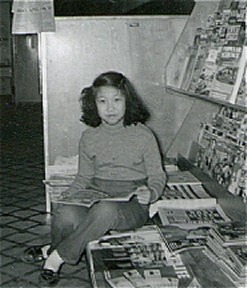
Air
Cadet PQ Jams and Bawdy Ballads
www.hillmanweb.com/cadets/cadetspromo.jpg
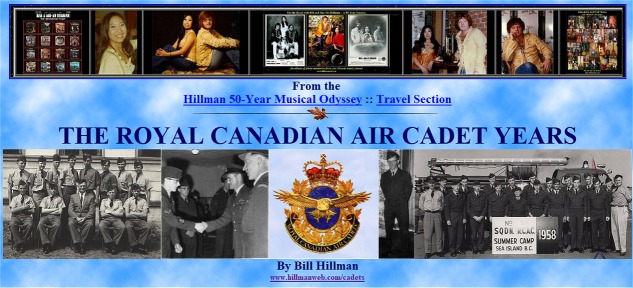
REMEMBERING THE AIR CADET YEARS
www.hillmanweb.com/cadets
I was a member of the Royal Canadian Air Cadets for eight
years -- having joined as a Junior Cadet at age 11. My two weeks at Air
Cadet 1960 Summer Camp in St. Jean, Quebec, gave me the opportunity to
jam with another guitarist -- a real treat because there were very few
players around home. He wasn't much better than I was, but he did a nice
version of Honky Tonk and soon I had another riff added to my slowly
growing guitar repertoire.
I had hoped to take pilot training in Cadets, but my
Nannie and the rest of the family would have no part of it. Memories of
the Wartime losses of only a decade before were still too horrific in their
memories. I had lost three uncles -- brothers to my Mom and Dad. They were
pilots in downed RCAF Lancaster and Halifax bombers.
Another memorable music experience associated with
Air Cadets was the singing of a seemingly limitless number of bawdy ballads
on the many military bus trips we took over the years -- songs I haven't
had much occasion to sing since, as there hasn't been much demand for them
in mixed company.
www.hillmanweb.com/cards/early/rememberall.jpg
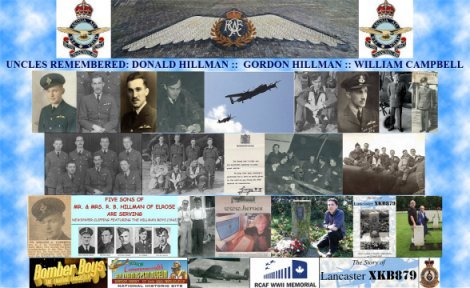
Electric
Silver Tones
My Harmony Monterey archtop had
served me well, but it had many limitations. One day in the summer of 1960,
while thumbing through the new Simpsons-Sears mail order catalogue, I came
upon a picture of a guitar that seemed to offer everything I wanted in
an instrument: a shiny black, gold-flecked Silvertone electric guitar.
The $100 price was way out of my range, but my grandmother had been saving
her pension cheques for an emergency such as this. The story and photos
of this guitar, and of all the guitars that came after are featured in
our Guitar Tales section.
Campbell
Christie Orchestra
Mom and her surviving older brother,
Don Campbell, had fond memories of the band that the three Campbell kids
and neighbouring Christie kids had formed back in the '30s. In 1960 my
obsession with music and the long hours I was spending with my new electric
guitar revived their interest in jamming together.
This led to a booking in Strathclair Municipal Hall
and what was to be my first stage appearance. Our repetoire consisted of
instrumental solos with my mom on piano and Barbara (Christie) Wyton on
violin. I might have played a few numbers, probably something like Wildwood
Flower and
Under the Double Eagle, and my Uncle Don played rhythm
guitar. We were pretty ragged and the whole experiment was short lived,
but it was an exciting and encouraging experience for me.
Neepawa
Variatones
Gordie Pierson was a travelling
hardware rep who made regular visits to my dad's hardware store. He played
often and always packed his accordion in the company car which he brought
out to our farm a few times for jams. I guess he saw some potential in
my guitar playing, so he invited me to sit in for a few dances with the
band he played with: the Neepawa Variatones. It was a good experience reading
chord symbols to accompany their horn arrangements. I was on my way . .
. ready for the big city : )
Don't
Worry 'bout Marty
The best teen dances of my youth
were at the Arena Dance Gardens in the nearby little town of Oak River.
One night's show back in the early '60s that stands out featured Marty
Robbins and his band. Marty was riding high with cross-over pop/country
hits that included the classic
El Paso. This was an event to look
forward to because of the great guitar work on his hits (the guitarist
on his recording sessions was usually Nashville legend, Grady Martin).
On this particular night, however, Marty's long-time
lead player (name forgotten) fell sick and had to leave the stage. Marty
ended up playing lead himself for the rest of the night . . . occasionally
sitting informally on the front edge of the stage.
This was the first time I had ever heard fuzz guitar
as the lead player had used the effect on Marty's hit, Don't Worry 'bout
Me. Story has it that the effect on Marty's recording was discovered
in the studio by accident when Grady's guitar solo was run through a guitar
amp with a loose tube or through a faulty channel in the mixing console.
Fascinated with the sound I bought the first fuzz pedal
-- a Maestro Fuzztone -- soon after. The fuzz/overdrive sound went on to
become a staple in the rock world. I was a real Marty fan and still have
many off-air, reel-to-reel tape recordings of Marty's all-night phone-in
request sessions on Ralph Emery's WSM radio show out of Nashville. Marty
sang and played every request that was phoned in to the station -- for
hours. He played guitar and piano behind these impromptu on-air vocals.
The
King of Skiffle Invades Manitoba
www.hillmanweb.com/cards/roots/doneganall.jpg
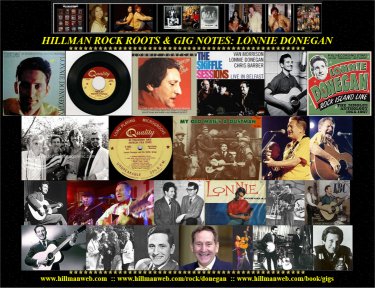 Lonnie Donegan was a major influence on British music.
Anthony James Donegan was born in Scotland in 1931. Early in his career
his jazz band (The Chris Barber Band) opened for bluesman Lonnie Johnson.
Donegan was a fan and in tribute he adopted the name Lonnie. He started
the skiffle craze that inspired an army of music lovers to pick up guitars
and look into American folk and blues music. Two young musicians who were
captivated by the driving skiffle sounds were John Lennon and Paul McCartney
from Liverpool. The repertoire of their first band was made up almost entirely
of skiffle songs and guitar styles.
Lonnie Donegan was a major influence on British music.
Anthony James Donegan was born in Scotland in 1931. Early in his career
his jazz band (The Chris Barber Band) opened for bluesman Lonnie Johnson.
Donegan was a fan and in tribute he adopted the name Lonnie. He started
the skiffle craze that inspired an army of music lovers to pick up guitars
and look into American folk and blues music. Two young musicians who were
captivated by the driving skiffle sounds were John Lennon and Paul McCartney
from Liverpool. The repertoire of their first band was made up almost entirely
of skiffle songs and guitar styles.
One of the first albums I bought back in the late '50s
was
Lonnie Donegan: An Englishman Sings American Folk Songs. A hotspot
for Donegan music in North America was Manitoba. Winnipeg radio stations
picked up on this album and started a groundswell for Lonnie's records
in the province. The most popular song off the album was "Frankie and Johnny"
-- a rather unusual choice for such radio play since it hadn't been released
as a single and its length was around five minutes -- in a time when nearly
all hits were 2-3 minutes long. Interestingly, the second track on side
2 of the album was "Nobody's Child" which Tony Sheridan covered five years
later in his recording session with the Beatles in Hamburg.
This explosion of Lonnie Donegan music came around
the time I had abandoned boring piano lessons and picked up my dad's Harmony
acoustic guitar. I had been scouring the radio dial looking for songs by
Elvis, Johnny Cash, Carl Perkins, Gene Vincent, Buddy Holly, et al, in
which the guitar and blues were the main driving force in this new groundbreaking
music called rock 'n' roll. Lonnie's brand of rockin' skiffle fit right
in. One of the first 45 rpm singles that I played on my new multi-speed
record player was Lonnie's frantic "Gamblin' Man."
Lonnie
Donegan Launches a Thousand Picks and Licks
I learned years later, during the
"English Rock Invasion," that I was not the only one deeply influenced
by Lonnie. Young Brits found it hard to obtain many US records and a burgeoning
domestic pop scene developed in the UK. Leading the pack was Lonnie Donegan,
"The King of Skiffle." His success was soon followed by homegrown acts
such as Cliff Richard and the Shadows.
Growing up in Canada in the '50s we were bombarded
by American culture to the south, but we still had very close ties to Britain
-- the best of both worlds. The success of Manitoba performers in the international
entertainment scene owes much to this multi-cultural exposure which made
them unique in many ways: comedians, folk and C/W singers, rock bands,
writers, TV personalities, actors, songwriters, etc. all benefited.
It is hard to find UK entertainers who came out of
the explosive '50s-'70s who don't admit to Donegan's influence on their
success. Up until the Beatles blitz he was Britain's most popular and successful
entertainer. When John Lennon formed the Quarrymen in 1957, Lonnie's songs
were riding the top of the British charts. The majority of the Quarrymen's
first songs were Donegan covers. In fact, the earliest known "Beatles"
recording is of Donegan's "Putting On the Style." Ironically, The Beatles'
success eclipsed Lonnie's popularity and he came to be considered passe
for too many years.
Lonnie's
Farewell
Sadly, I never had the opportunity
to meet Lonnie Donegan or hear him in person. The closest I got to the
man was during our 1976 tour of England -- we even played some of Lonnie's
hits on our shows. Our MC/comedian for one of the workingman club gigs
we played had emceed Lonnie's show the night before. I pestered the poor
guy all night with questions about the Skiffle King.
Earlier in the year, Lonnie had suffered a heart attack
and undergone a heart operation, and the show the night before was billed
as a farewell concert. A few years later, however, veteran trouper that
he was, Lonnie returned to show biz. Two of my favourite albums came later
in Lonnie's career: He was joined on the 1978 "Puttin' On The Style" sessions
by a host of rockers who wanted to acknowledge his influence on their music.
Among the guests on the album were Ringo Starr, Leo Sayer, Albert Lee,
Brian May, Elton John, Klaus Voorman, Ronnie Wood, Jim Keltner, Nicky Hopkins,
Rory Gallagher, Alan Jones, and many more.
Much later, his acclaimed "Live in Belfast 1998" album
was done with Van Morrison, Chris Barber, and Dr. John. Lonnie Donegan
died in 2002, aged 71, after suffering a heart attack while on tour, shortly
before he was due to perform at a memorial concert for George Harrison
with The Rolling Stones. I owe a great debt to this man who introduced
me to American blues and folk music, English music hall performances, and
Jazz, dixieland, and skiffle -- and fed into my passion for guitar.
THE
HILLMAN / STRATHCLAIR MUSIC CONNECTION
www.hillmanweb.com/cards/roots2/hillmans2strathclair.jpg
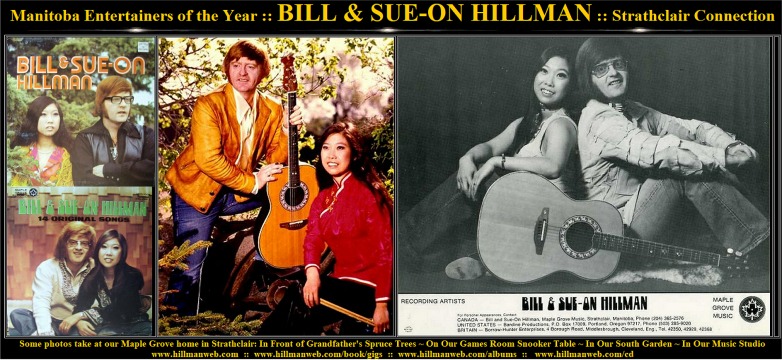 Our connection with Strathclair has played a major part
in our six-decades-long musical career. Much of my inspiration came from
my parents, Jerry and Louise. My Mom and her brothers, Don and Bill, had
teamed up with the Christie family kids to form the Campbell-Christie Orchestra
in Strathclair back in the '30s. During WWII, after my birth in Strathclair,
my mom and I followed my dad to his Royal Canadian Navy postings in Newfoundland,
Halifax and Vancouver Island. My first memories of music were my parents'
jam sessions at those locations. . . and then later in the '50s on our
Maple Grove farm south of Strathclair. There was always music in our house
from a stack of 78 records, radios and later, TV. After Dad bought me my
first guitar and showed me a few chords, my first appearance on stage was
with the family in the Strathclair Hall. When Sue-On and I married in 1966,
we formed the Western Union band and some of our first appearances were
in that same hall, and in the Strathclair Hotel pub, and much later in
the Strathclair Arena and Strathclair Collegiate.
Our connection with Strathclair has played a major part
in our six-decades-long musical career. Much of my inspiration came from
my parents, Jerry and Louise. My Mom and her brothers, Don and Bill, had
teamed up with the Christie family kids to form the Campbell-Christie Orchestra
in Strathclair back in the '30s. During WWII, after my birth in Strathclair,
my mom and I followed my dad to his Royal Canadian Navy postings in Newfoundland,
Halifax and Vancouver Island. My first memories of music were my parents'
jam sessions at those locations. . . and then later in the '50s on our
Maple Grove farm south of Strathclair. There was always music in our house
from a stack of 78 records, radios and later, TV. After Dad bought me my
first guitar and showed me a few chords, my first appearance on stage was
with the family in the Strathclair Hall. When Sue-On and I married in 1966,
we formed the Western Union band and some of our first appearances were
in that same hall, and in the Strathclair Hotel pub, and much later in
the Strathclair Arena and Strathclair Collegiate.
Through the years, Strathclair was home base for us
as we played countless major gigs all across the prairies, USA, and England
where we were billed "The Hillmans From Canada." The English audiences
were a bit leery of our "Yankee Accents" at first, but we were met with
overwhelming acceptance when they learned we were from Canada -- "O the
Colonies! -- Welcome home!" :) We even had many of them convinced that
Strathclair was a major centre in Canada.
Our trio's succession of "third men" for these International
tours were all from Strathclair: Kevin Pahl, Kerry Morris and our son,
Robin. In fact, Robin's debut on drums was in Strathclair Hall where the
little 8-year-old joined us on stage for some rockers, including his spirited
interpretation of the Rolling Stones' "Satisfaction." Robin went on to
join us as the third man in our trio playing drums, bass and trombone.
Our daughter China-Li has joined us for a series of Folk Festival appearances
playing harp, bagpipes and keyboards. Son Ja-On is an accomplished saxophonist
and has taught the instrument for a number of years. All three of our kids,
Ja-On, Robin and China-Li owe much of their success in music to their early
years in Strathclair.
The 100 songs on our 12 music albums were recorded
during our three tours in England and in a modern Westlake studio in Winnipeg.
But they were all rehearsed in our Strathclair home -- and half of them
I wrote there . . . many of them about our experiences growing up on our
farm and in our little town. Many of the photos that we used on our albums,
books, promos, press releases, etc. were taken at our beloved Maple Grove
home.
All during our music years while based in Strathclair
we were visited by a constant stream of well-known musicians, journalists,
TV reporters, etc. -- especially after we were presented the Manitoba Entertainers
of the Year Award by MACA. This carried on even after we moved to Brandon
to open our restaurant and join Brandon University to work as professors.
When CBC National Television filmed a feature documentary on us we invited
the film crew back to Strathclair for half the filming. We were pleased
to see a blurb on us in the local history books, although for some reason,
lead singer Sue-On, who also plays keyboards and is our dynamic drummer,
was credited as “playing castanets and maracas in a band.” Wow! we're
going to have to find some castanets somewhere so Sue-On can take some
Flamenco dance lessons :)
We have fond memories of our Strathclair years.
www.hillmanweb.com/cards/roots2/albumsall.jpg
